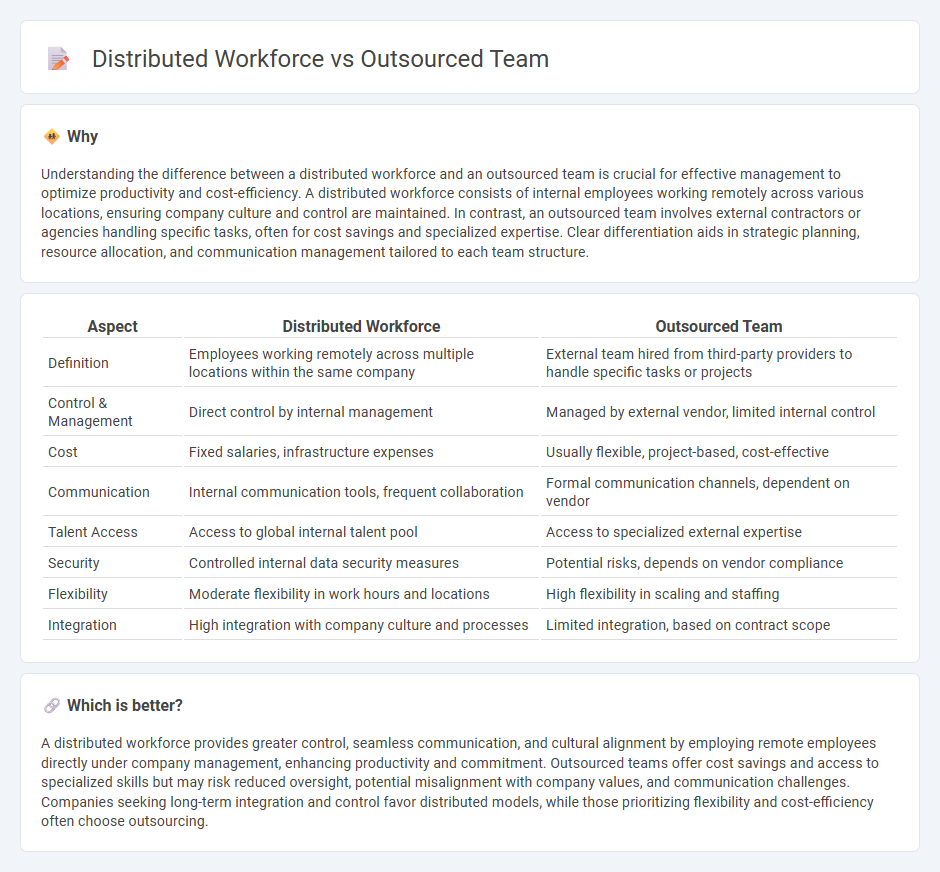
Distributed workforce models leverage geographically dispersed employees directly managed by the company, enhancing control over team dynamics and corporate culture. Outsourced teams consist of external service providers handling specific tasks or projects, often resulting in cost savings and flexible scaling options. Explore effective management strategies to optimize performance in both distributed and outsourced team structures.
Why it is important
Understanding the difference between a distributed workforce and an outsourced team is crucial for effective management to optimize productivity and cost-efficiency. A distributed workforce consists of internal employees working remotely across various locations, ensuring company culture and control are maintained. In contrast, an outsourced team involves external contractors or agencies handling specific tasks, often for cost savings and specialized expertise. Clear differentiation aids in strategic planning, resource allocation, and communication management tailored to each team structure.
Comparison Table
| Aspect | Distributed Workforce | Outsourced Team |
|---|---|---|
| Definition | Employees working remotely across multiple locations within the same company | External team hired from third-party providers to handle specific tasks or projects |
| Control & Management | Direct control by internal management | Managed by external vendor, limited internal control |
| Cost | Fixed salaries, infrastructure expenses | Usually flexible, project-based, cost-effective |
| Communication | Internal communication tools, frequent collaboration | Formal communication channels, dependent on vendor |
| Talent Access | Access to global internal talent pool | Access to specialized external expertise |
| Security | Controlled internal data security measures | Potential risks, depends on vendor compliance |
| Flexibility | Moderate flexibility in work hours and locations | High flexibility in scaling and staffing |
| Integration | High integration with company culture and processes | Limited integration, based on contract scope |
Which is better?
A distributed workforce provides greater control, seamless communication, and cultural alignment by employing remote employees directly under company management, enhancing productivity and commitment. Outsourced teams offer cost savings and access to specialized skills but may risk reduced oversight, potential misalignment with company values, and communication challenges. Companies seeking long-term integration and control favor distributed models, while those prioritizing flexibility and cost-efficiency often choose outsourcing.
Connection
A distributed workforce relies on geographically dispersed employees working remotely, often requiring effective management tools and communication strategies to maintain productivity. Outsourced teams represent a subset of distributed workforce models, where external specialists handle specific tasks or projects, integrating with internal teams despite physical distance. Both approaches emphasize flexibility, cost-efficiency, and leveraging global talent pools to drive business growth.
Key Terms
Control
An outsourced team offers companies defined control through contractual agreements and project-specific deliverables, ensuring clear accountability and centralized management. A distributed workforce provides more flexible control but requires robust communication tools and strong leadership to maintain productivity across diverse locations. Explore how choosing between these models impacts your operational control strategies.
Communication
Effective communication in an outsourced team often relies on structured protocols and defined points of contact to manage interactions across different organizations. A distributed workforce emphasizes real-time collaboration tools and cultural alignment to foster seamless communication among geographically dispersed internal teams. Explore in-depth strategies to enhance communication efficiency in both setups.
Flexibility
Outsourced teams provide businesses with specialized skills by delegating specific projects to external agencies, offering high flexibility in scaling resources quickly. Distributed workforces consist of company employees working remotely from various locations, enhancing flexibility through continuous collaboration across time zones and diverse work environments. Discover the key differences to optimize your organization's flexibility and productivity strategies.
Source and External Links
In-House vs. Outsourced Teams: Which Option Best Suits Your ... - Outsourced teams offer flexibility, cost savings, faster project completion, and access to global and specialized talent compared to in-house teams, which can face longer recruitment times and limited local talent pools.
How to Select the Right Outsourced Development Team - There are key models of outsourced teams such as integrated teams that fill gaps alongside your internal staff and dedicated teams which provide turnkey project delivery, each suited to different project needs.
How to Manage an Outsourced Team - Deazy - Effective outsourced team management involves clear objectives, communication, organizational structure, and proactive engagement to overcome challenges related to remote collaboration and ensure productivity.
 dowidth.com
dowidth.com